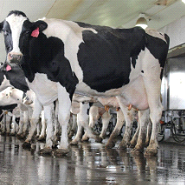Ozone As a Sanitizer in CIP Systems
Ozone has been used extensively in the beverage industry for disinfection of the product, bottles and fillers. The use of ozone in this industry has been widespread since the FDA gave ozone GRAS approval in November 1992 (21 CFR 184.1563). The use of ozone as a surface sanitizer and for direct contact with food, has also grown. In 2001, ozone was given a GRAS approval for direct contact with all meat and poultry products (FSIS Directive 7120.1).
Benefits of Ozone Use in CIP Processes
- Ozone has no residuals or by-products that could alter flavors of a beverage or other product
- Ozone sanitation may replace hot water cycles, lowering energy costs
- Chemicals like chlorine or other sanitizers can be eliminated, saving cost and labor in handling / transporting chemicals
- CIP rinse / cleaning cycles can be combined using ozone, saving water and time - this may allow for more processing time, due to a shorter CIP cycle time

Potential Cost Savings of Ozone Use in CIP Processes
- Water savings due to fewer cycles during CIP processes
- Chemical amounts may be reduced, saving chemical costs
- Water savings will translate to less wastewater and potentially cleaner wastewater, eliminating chemical by-products
- Fewer CIP cycles, shortens overall downtime for the CIP process
- Energy costs may be lowered due to less hot water consumption
Ozone Use for CIP Systems in the Beverage Industry
The use of ozone in the beverage industry can be attributed to process and downtime improvements more than cost savings. In the wine and beer industries, ozone is very attractive due to the sensitive nature of the final products. Ozone is very attractive as there is no residual left behind by the sanitation process to alter the flavor of the wine or beer.
The journal of the International Ozone Association published a paper on ozone use for CIP systems in the wine industry. This paper can be viewed and purchased here.
Other applications in the beverage industries have favored the use of ozone strictly for cost saving measures. With less downtime from the CIP process, production can be increased. A study from 2008 at a beverage plant found total cuts to the CIP process saved 180 minutes each production day. This resulted in a dramatic profitability improvement to this plant.

|

|

|
Ozone Use for CIP Systems in Food Extraction Processes
Extraction processes are continually evolving and using new methods to extract biological components from food products. In the past, many extraction processes used heat and chemicals to dissolve biological components in food products. Today many extraction processes are using cooler and less harsh methods to extract desired proteins. This creates a microbiological concern in the product and manufacturing environment. Ozone has been used successfully in the gaseous form to disinfect the final product, but also in the CIP processes of these systems. Due the lack of residual left by ozone it is an attractive solution to the microbiological problems that may be present in these applications.
Oxidizing Potential of Ozone
Ozone is the strongest oxidant on the market. Other chemical solutions just can't compare.
Ozone Use at Dairy Farms in the CIP Process
 When thinking of CIP processes, dairy farms are not usually the first application that comes to mind. However, dairy farms are one of the most common CIP processes used.
When thinking of CIP processes, dairy farms are not usually the first application that comes to mind. However, dairy farms are one of the most common CIP processes used.
Each modern dairy farm uses a pipeline to carry the milk from the individual milking station to the final bulk tank (with a few stops in between). Dairy farms are required to clean these pipes after every milking, which may be 2 or 3 times per day. Traditionally hot water with chemicals were used in these processes consuming a large amount of energy and chemical costs. The use of ozone can cut down on energy and chemical costs.
Ozone as a Sanitizer
Ozone is an extremely effective sanitizer. Historically the most common sanitizer used in CIP systems has been chlorine. While chlorine is a very effective disinfectant, it has the potential to leave residuals and create potentially harmful by-products. Other chemicals, caustics and acids are used in the CIP process as well. All of these have challenges with storage, handling and transportation due to increasing regulation. These factors along with rising costs have broadened the use of ozone in many applications.
